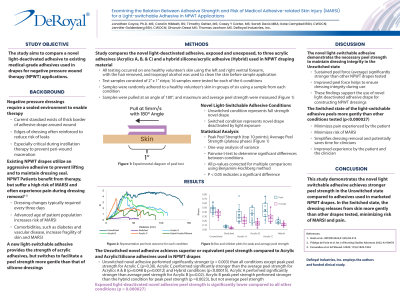Laboratory Research
(LR-006) Examining the Relation Between Adhesive Strength and Medical Adhesive-related Skin Injury (MARSI) Risk for a Light-switchable Adhesive for NPWT Applications
Friday, May 2, 2025
7:45 PM - 8:45 PM East Coast USA Time

Caroline Hibbett, B.S.; Timothy Oetter, M.S., B.S.; Casey Carter, M.S., B.S.; Sarah Davis, MBA, B.S.; Kate Campbell, BSN, RN, CWOCN; Jennifer Goldenburg, BSN, RN, CWOCN; Dhanvin Desai, M.S., B.S.; Thomas Lawhorn, M.S., B.S.
Introduction:
Patients who require negative pressure wound therapy (NPWT) represent a cohort at significant risk for medical adhesive-related skin injury (MARSI). NPWT dressings require strong medical adhesives to maintain the dressing seal for effective therapy. Most dressings require frequent changing, typically every three days. Further, patients requiring NPWT often suffer from comorbidities, such as diabetes and vascular disease. Each of these factors increases MARSI risk.1-3 A drape dressing with light-switchable adhesive may offer clinicians a dressing with strong adhesive strength during therapy but gentle release when exposed to near-UV light (“switched”), minimizing the risk of MARSI. This study compares a new, light-switchable adhesive drape to acrylic and hybrid adhesive drapes currently used for NPWT dressings.
Methods: The study used peel strength testing to compare the light-switchable adhesive to three acrylic adhesives and one silicone-acrylic hybrid adhesive drape used in NPWT dressings. The light-switchable adhesive had two groups: unswitched and switched. Researchers randomly adhered 1X2" samples in groups of six on a healthy volunteer's ventral forearm using one inch of the sample and left samples in place for one hour. Researchers then secured the unattached second half with a clamp on a universal testing machine and pulled each sample at a 180° angle and 5 mm per second. The results report the average maximum peel strength (Newtons) and 95% confidence interval (n=8). Statistical analysis used a one-way analysis of variance followed by paired-wise t-tests. Reported p-values underwent adjustment using the Benjamini-Hochberg method for multiple comparisons. A p-value of less than 0.05 indicates a significant difference.
Results:
Unswitched adhesive exhibited an average maximum peel strength of 4.45+/-0.56 N compared to Acrylic A 2.74+/-0.78 N, Acrylic B 2.77+/-1.02 N, Acrylic C 4.57+/-1.12 N, and Hybrid 1.77+/-0.43 N. Switched adhesive decreased in average maximum peel strength to 0.60+/-0.21 N. The ANOVA indicated a significant difference (p=7.74E-10). Pairwise testing found that the switched adhesive had a significantly lower peel strength than all other conditions (p-value range: 3.03E-06-0.0063). The Unswitched adhesive and Acrylic C had higher peel strength than the Hybrid (p=9.56E-06 and p=0.002), Acrylic A (p=0.004 and 0.020), and Acrylic B (p=0.021 and 0.036). Acrylic A exhibited increased peel strength compared to the Hybrid (p=0.048).
Discussion: The study results show a profound decrease in peel strength in the light-switched adhesive compared to its unswitched state. Using an NPWT drape with light-switchable adhesive for NPWT applications may help to address challenges in securing a dressing while preventing MARSI.
Patients who require negative pressure wound therapy (NPWT) represent a cohort at significant risk for medical adhesive-related skin injury (MARSI). NPWT dressings require strong medical adhesives to maintain the dressing seal for effective therapy. Most dressings require frequent changing, typically every three days. Further, patients requiring NPWT often suffer from comorbidities, such as diabetes and vascular disease. Each of these factors increases MARSI risk.1-3 A drape dressing with light-switchable adhesive may offer clinicians a dressing with strong adhesive strength during therapy but gentle release when exposed to near-UV light (“switched”), minimizing the risk of MARSI. This study compares a new, light-switchable adhesive drape to acrylic and hybrid adhesive drapes currently used for NPWT dressings.
Methods: The study used peel strength testing to compare the light-switchable adhesive to three acrylic adhesives and one silicone-acrylic hybrid adhesive drape used in NPWT dressings. The light-switchable adhesive had two groups: unswitched and switched. Researchers randomly adhered 1X2" samples in groups of six on a healthy volunteer's ventral forearm using one inch of the sample and left samples in place for one hour. Researchers then secured the unattached second half with a clamp on a universal testing machine and pulled each sample at a 180° angle and 5 mm per second. The results report the average maximum peel strength (Newtons) and 95% confidence interval (n=8). Statistical analysis used a one-way analysis of variance followed by paired-wise t-tests. Reported p-values underwent adjustment using the Benjamini-Hochberg method for multiple comparisons. A p-value of less than 0.05 indicates a significant difference.
Results:
Unswitched adhesive exhibited an average maximum peel strength of 4.45+/-0.56 N compared to Acrylic A 2.74+/-0.78 N, Acrylic B 2.77+/-1.02 N, Acrylic C 4.57+/-1.12 N, and Hybrid 1.77+/-0.43 N. Switched adhesive decreased in average maximum peel strength to 0.60+/-0.21 N. The ANOVA indicated a significant difference (p=7.74E-10). Pairwise testing found that the switched adhesive had a significantly lower peel strength than all other conditions (p-value range: 3.03E-06-0.0063). The Unswitched adhesive and Acrylic C had higher peel strength than the Hybrid (p=9.56E-06 and p=0.002), Acrylic A (p=0.004 and 0.020), and Acrylic B (p=0.021 and 0.036). Acrylic A exhibited increased peel strength compared to the Hybrid (p=0.048).
Discussion: The study results show a profound decrease in peel strength in the light-switched adhesive compared to its unswitched state. Using an NPWT drape with light-switchable adhesive for NPWT applications may help to address challenges in securing a dressing while preventing MARSI.

.jpg)